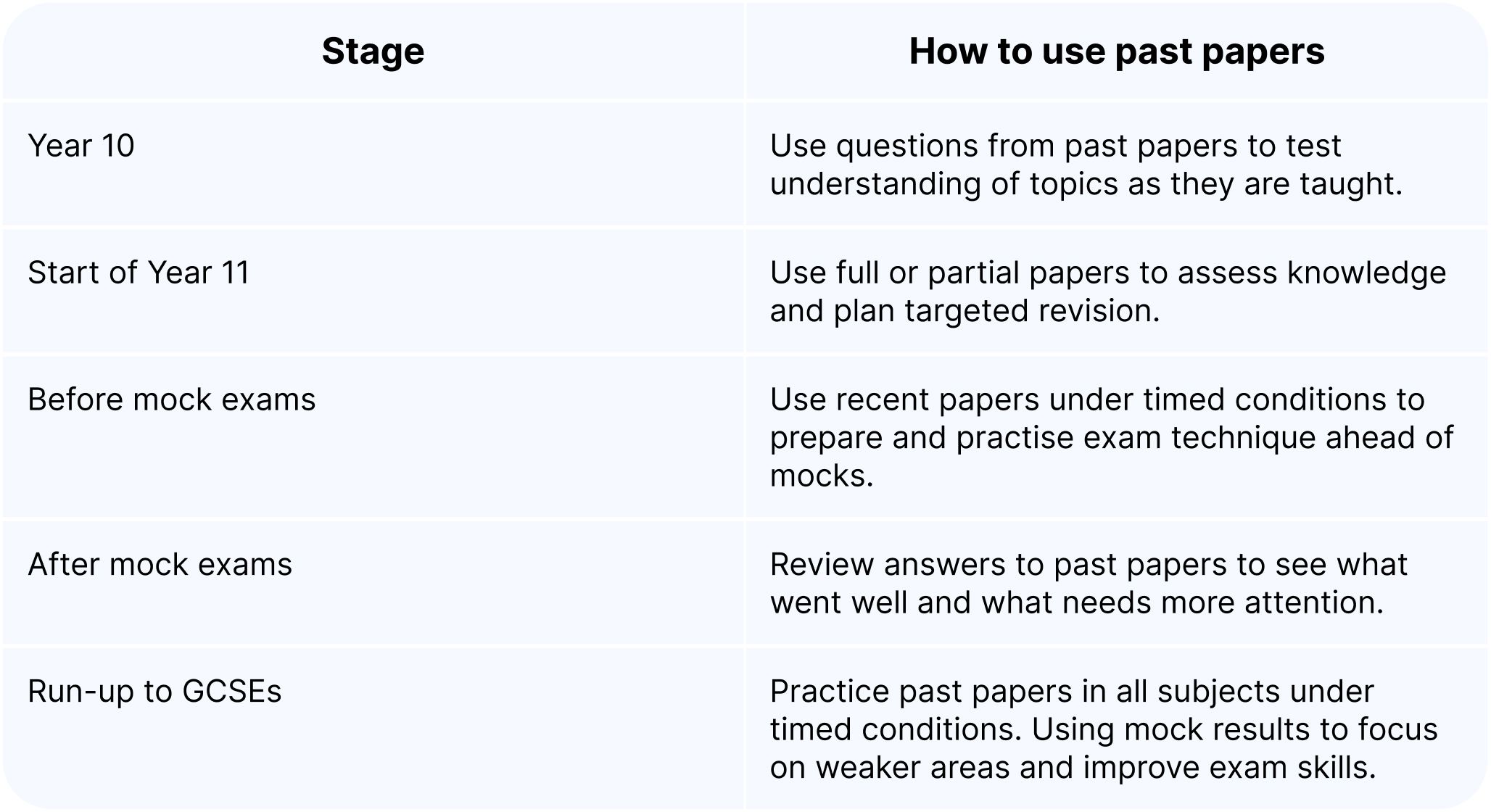Contents
Effective GCSE revision isn’t just about covering content; it’s about using the right methods to make it count on exam day. One of the most useful tools you can use is GCSE past papers.
Whether it’s preparing for GCSE mock exams or fine-tuning exam techniques ahead of the final exam, using past papers helps you to build confidence, identify gaps, and feel ready for exam day.
In this blog, we’ll cover:
Why GCSE past papers are so useful for revision
How to use past papers at different stages of Year 10 and Year 11
Strategies to improve recall, including the blurting method
When and how to use GCSE mock exam papers
Why GCSE past papers are such a powerful revision tool
GCSE past papers (also referred to as practice papers) are real exam papers from previous GCSE years.
They provide the opportunity to:
Get familiar with the style and structure of exam questions
Practise timings under exam conditions
Spot common question types and understand what exam boards look for in top-mark answers
Identify knowledge gaps early so that they can revise more efficiently
Recognise how different exam boards structure their questions and formats
Working through past papers is one of the most effective ways to revise, as it transforms passive revision, such as reading notes or highlighting a textbook, into active revision, where you can actually apply what you’ve learned.
Free revision timetable template & more
Less stress, more success! Get your free revision timetable templates and guide to effective revision today. Because great revision starts with a solid plan.
When should you start using past papers?
The best time to start using past papers depends on where you are in their GCSE journey. Here’s a simple guide:

It’s important to remember that past papers are most effective when you've had the opportunity to learn the topic first. The goal is to use past papers to check understanding and apply knowledge, not to catch yourself out.
Techniques to get the most from past paper practice
1. Use the blurting method to test recall
The blurting method is an effective way to revise using past papers. Rather than reading through notes or passively highlighting a textbook, this method encourages you to retrieve information from memory, a proven way to strengthen long-term understanding.
Here’s how it works:
Choose a question from a past paper.
Without using notes, write down everything remembered about the topic - this is the “blurting” stage.
Then, compare the response to the revision notes or the mark scheme. Highlight missing information or any errors using a different colour.
Use the gaps as a prompt for targeted revision.
This technique strengthens active recall and highlights areas that need further revision. It’s especially useful for short-answer or topic-specific questions in the earlier stages of revision.
2. Understanding official GCSE mark schemes
Mark schemes provided by exam boards are essential for understanding how marks are awarded. They can help you see what examiners are looking for, how to structure answers effectively, and learn what’s expected from different types of questions.
Here’s what to look out for:
Command words – such as “describe”, “explain”, or “evaluate”, which indicate the type and depth of response required
Key phrases and terminology – subject-specific vocabulary that must be included for full marks
Point-by-point breakdowns – showing how marks are allocated across multi-part or extended questions
Model or exemplar responses – examples of what a top-mark answer might look like
Common errors or misconceptions – helping you learn what to avoid
Credit-worthy ideas – a list of acceptable answers, especially in longer or more open-ended questions
Mark schemes are most valuable when used to review answers honestly and reflect on what could be improved. It’s not about getting every mark right; it’s about learning from mistakes and using them to make meaningful progress in GCSE preparation.
3. Practise past papers in exam conditions
One of the most effective ways to prepare for GCSE exams is to complete past papers under realistic, timed conditions.
It’s not just about completing the questions, it’s about practising in a way that feels like the real exam. This helps you become more familiar with the pressure, structure, and timing they’ll face on the exam day.
Practising in exam-like conditions supports:
Time management – learning how to pace answers and avoid running out of time
Focus and concentration – building the stamina to stay engaged through a full paper
Exam technique – practising how to approach different question types and follow instructions carefully
Confidence under pressure – reducing nerves by making the experience more familiar
To create exam-like conditions at home:
Choose a quiet, distraction-free space
Set a timer for the full duration of the paper
Use only the materials allowed in the actual exam, as listed on the front of the past paper (e.g. pen, calculator, ruler)
Complete the entire paper in one sitting
Mark the paper using the official mark scheme or ask a teacher to help review key answers
This type of practice is one of the most effective ways to enhance exam performance. By regularly completing past papers under exam-like conditions, you can make your revision more targeted and effective, feel more prepared for the real thing, and go into your GCSEs with greater confidence.
Where to find GCSE past papers?
Students and parents can find past papers on the official websites for each exam board. These sites include both papers and mark schemes:
Supporting your teen with past paper revision
For parents, helping your teen use GCSE past papers doesn’t require subject knowledge; it’s about setting up the right environment:
Create structure: Help build a revision timetable that includes regular practice with past papers.
Timed practice sessions: Act as a timekeeper or invigilator to replicate real GCSE exam conditions.
Discuss progress: Encourage your child to reflect on what went well and where they can improve.
Promote balance: Ensure there’s time for rest, movement, and breaks to maintain high motivation.
Final thoughts: Using past papers to build confidence
Past paper practice is more than just a way to revise; it’s a confidence builder. It provides you with the tools to approach exams with a clear understanding of what to expect and how to succeed.
Whether you're is preparing for GCSE mock exams or working towards your final summer assessments, regular use of practice papers can make all the difference.
Don’t miss Atom’s GCSE giveaway!

Six months. Six epic prizes. Six chances to make the GCSE season unforgettable.
We’re launching Atom for GCSE prep in 2026, and to celebrate, over the next six months, we’re giving away thousands of pounds worth of prizes to help your child level up their GCSE revision.
Here’s a taste of what’s up for grabs:
The latest Apple tech, including an iPad Air, Vision Pro and more
Festival tickets for Boardmasters and Reading 2026
Europe interrail passes and £1,000 spending money
…and that’s just a few of the amazing prizes available.
Our first two winners have already taken home incredible prizes! Find out who they are and what they won in our latest giveaway update and keep an eye out for news of our November winner.
It’s free to join. UK only. Full T&Cs apply.
Contents
